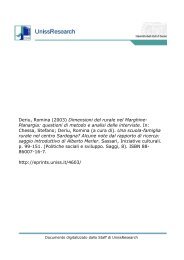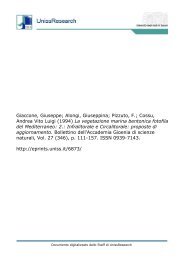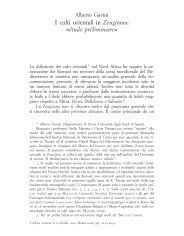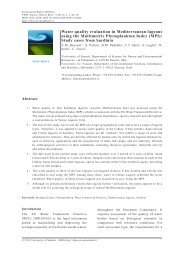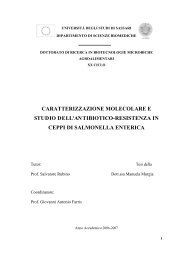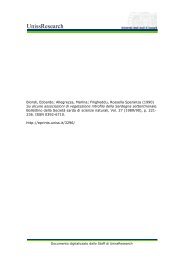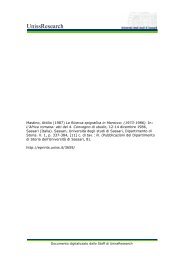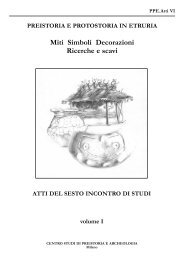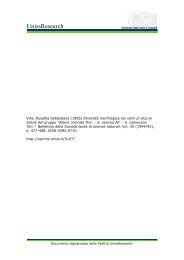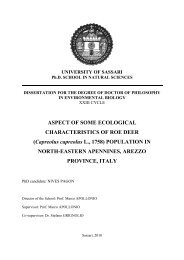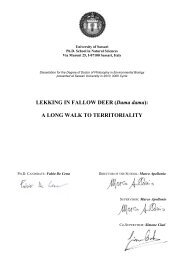Sanciu, Antonio (2002) Lucerne con bolli di fabbrica dal porto di ...
Sanciu, Antonio (2002) Lucerne con bolli di fabbrica dal porto di ...
Sanciu, Antonio (2002) Lucerne con bolli di fabbrica dal porto di ...
Create successful ePaper yourself
Turn your PDF publications into a flip-book with our unique Google optimized e-Paper software.
<strong>Sanciu</strong>, <strong>Antonio</strong> (<strong>2002</strong>) <strong>Lucerne</strong> <strong>con</strong> <strong>bolli</strong> <strong>di</strong> <strong>fabbrica</strong> <strong>dal</strong><br />
<strong>porto</strong> <strong>di</strong> Olbia. In: L'Africa romana: atti del 14. Convegno <strong>di</strong><br />
stu<strong>di</strong>o, 7-10 <strong>di</strong>cembre 2000, Sassari, Italia. Roma, Carocci<br />
e<strong>di</strong>tore. V. 2, p. 1281-1299: ill. (Collana del Dipartimento <strong>di</strong><br />
Storia dell’Università degli Stu<strong>di</strong> <strong>di</strong> Sassari. N. S., 13.2;<br />
Pubblicazioni del Centro <strong>di</strong> stu<strong>di</strong> inter<strong>di</strong>sciplinari sulle<br />
Province romane dell’Università degli stu<strong>di</strong> <strong>di</strong> Sassari,<br />
13.2). ISBN 88-430-2429-9.<br />
http://eprints.uniss.it/6327/<br />
Documento <strong>di</strong>gitalizzato <strong>dal</strong>lo Staff <strong>di</strong> UnissResearch
AD MDLXII<br />
Collana del Dipartimento <strong>di</strong> Storia<br />
dell'Università degli Stu<strong>di</strong> <strong>di</strong> Sassari<br />
Nuova serie <strong>di</strong>retta da Mario Da Passano, Attilio Mastino,<br />
Antonello Mattone, Giuseppe Meloni<br />
Pubblicazioni del Centro <strong>di</strong> Stu<strong>di</strong> Inter<strong>di</strong>sciplinari sulle Province Romane<br />
dell'Università degli Stu<strong>di</strong> <strong>di</strong> Sassari
L'Africa<br />
romana<br />
Lo spazio marittimo del Me<strong>di</strong>terraneo occidentale:<br />
geografia storica ed e<strong>con</strong>omia<br />
Atti del XIV <strong>con</strong>vegno <strong>di</strong> stu<strong>di</strong>o<br />
Sassari, 7-10 <strong>di</strong>cembre 2000<br />
A cura <strong>di</strong> Mustapha Khanoussi, Paola Ruggeri, Cinzia Vismara<br />
Volume se<strong>con</strong>do<br />
Carocci e<strong>di</strong>tore
Volume pubblicato <strong>con</strong> il <strong>con</strong>tributo finanziario<br />
della Fondazione Banco <strong>di</strong> Sardegna<br />
la e<strong>di</strong>zione, novembre <strong>2002</strong><br />
© copyright <strong>2002</strong> by<br />
Carocci e<strong>di</strong>tore S.p.A., Roma<br />
Finito <strong>di</strong> stampare nel novembre <strong>2002</strong><br />
<strong>dal</strong>le Arti Grafiche E<strong>di</strong>toriali srl, Urbino<br />
ISBN 88-430-2429-9<br />
Riproduzione vietata ai sensi <strong>di</strong> legge<br />
(art. 171 della legge 22 aprile 1941, n. 633)<br />
Senza regolare autorizzazione,<br />
è vietato riprodurre questo volume<br />
anche parzialmente e <strong>con</strong> qualsiasi mezzo,<br />
compresa la fotocopia,<br />
anche per uso interno<br />
o <strong>di</strong>dattico.
<strong>Antonio</strong> <strong>Sanciu</strong><br />
<strong>Lucerne</strong> <strong>con</strong> <strong>bolli</strong> <strong>di</strong> <strong>fabbrica</strong><br />
<strong>dal</strong> <strong>porto</strong> <strong>di</strong> Olbia<br />
I fon<strong>dal</strong>i del <strong>porto</strong> <strong>di</strong> Olbia hanno restituito un <strong>con</strong>sistente numero <strong>di</strong> lucerne<br />
fittili d'età romana. Quasi tutte presentano sicure tracce d'utilizzo<br />
e furono probabilmente gettate in acqua, o comunque vi finirono, dopo<br />
che si erano rotte. Anche negli esemplari meglio <strong>con</strong>servati si ris<strong>con</strong>trano,<br />
spesso, fratture in antico in corrispondenza del beccuccio, che è sempre<br />
annerito per l'uso. Naturalmente non è possibile <strong>di</strong>re quali lucerne<br />
siano state buttate in mare, o siano cadute, da navi qui ancorate, e dunque<br />
facessero parte delle dotazioni <strong>di</strong> bordo (non del carico, poiché già<br />
usate), e quali invece provengano da terra. In tutti i casi, questi oggetti devono<br />
essere stati coperti subito dai fanghi del fon<strong>dal</strong>e, poiché non si osserva<br />
quasi mai, sulla loro superficie, la presenza <strong>di</strong> incrostazioni marine.<br />
In questo <strong>con</strong>vegno, allo scopo <strong>di</strong> dare un <strong>con</strong>tributo al corpus delle<br />
iscrizioni sull' instrumentum domesticum rinvenuto in Sardegna, si presentano<br />
soltanto le lucerne <strong>con</strong> <strong>bolli</strong> <strong>di</strong> <strong>fabbrica</strong>, riservando ad altra sede<br />
la pubblicazione <strong>di</strong> tutto il resto del materiale. L'estrapolazione è in questo<br />
caso giustificata soprattutto in <strong>con</strong>siderazione della mancanza <strong>di</strong> stratigrafie<br />
nei fon<strong>dal</strong>i interrati ave è avvenuto il recupero dei relitti l •<br />
Le lucerne vengono presentate per aree geografiche <strong>di</strong> produzione,<br />
iniziando <strong>con</strong> le firme <strong>di</strong> probabile attribuzione a officine centro italiche<br />
2 •<br />
I. Per tutte le informazioni riguardanti lo scavo del fon<strong>dal</strong>e del <strong>porto</strong> <strong>di</strong> Olbia e dei<br />
relitti ivi affondati cfr., in questi Atti, i <strong>con</strong>tributi <strong>di</strong> R. D'Oriano (pp. 1249-62), E. Riccar<strong>di</strong><br />
(pp. 1263-74) e G. Pisanu (pp. 1275-80). I dati che qui si presentano sono aggiornati<br />
al mese <strong>di</strong> ottobre del 2000. La documentazione grafica delle lucerne è <strong>di</strong> G. Sedda,<br />
quella fotografica è <strong>di</strong> E. Grixoni.<br />
2. Questo scritto serba il carattere <strong>di</strong>scorsivo della comunicazione tenuta al <strong>con</strong>vegno<br />
e per questo motivo, anche se è <strong>con</strong>suetu<strong>di</strong>ne presentare i <strong>bolli</strong> in sequenza alfabetica,<br />
si è preferito seguire l'or<strong>di</strong>ne su esposto. Per la classificazione si è fatto riferimento<br />
alle seguenti tipologie: Dressel = E. DRESsEL, Lucernarum jormae, in CIL xv, 2, l, Berolini<br />
1899, tav. III; Loeschcke = S. LOESCHCKE, Lampen aus Vindonissa. Ein Beitrag zur Geschichte<br />
von Vindonissa und des antiken Beleuchtungswesens, Ziirich 1919; Broneer = O.<br />
L'Africa romana XN, Sassari 2000, Roma <strong>2002</strong>, pp. 1281-1300.
<strong>Lucerne</strong> <strong>con</strong> <strong>bolli</strong> <strong>di</strong><strong>fabbrica</strong> <strong>dal</strong> <strong>porto</strong> <strong>di</strong> Olbia<br />
ANNISER = Anni Ser(apidori). Lo stesso bollo è attestato anche su altri<br />
due frammenti <strong>di</strong> fon<strong>di</strong> <strong>di</strong> lucerne, forse del tipo Bailey Q, gruppo x,<br />
provenienti sempre <strong>dal</strong> <strong>porto</strong>: L 4 (TAV. II,I; FIG. 6,3) (lu. r. 5 ca., la. 7,2<br />
ca.) = A[N]NISER e L 24 (TAV. II,2; FIG. 6,4) (lu. r. 5,4, la. r. 3,7) =<br />
[A]NNISER. Si tratta <strong>di</strong> una <strong>fabbrica</strong>, probabilmente ostiense, che fiorisce<br />
nella prima metà del III secolo d.C. e forse anche già <strong>dal</strong>la fine del secolo<br />
precedente 3 • Le lucerne <strong>di</strong> Annius Serapidorus sono già note in Sardegna<br />
4 e una <strong>di</strong> esse proviene <strong>dal</strong>la stessa Olbia 5 • Per quanto riguarda la<br />
decorazione sul <strong>di</strong>sco, si deve segnalare che il crescente lunare è un motivo<br />
ben <strong>di</strong>ffuso, ma compare soprattutto su lucerne tipo Deneauve VII A G •<br />
Potrebbe essere attribuibile al tipo Bailey Q, gruppo x, anche la lucerna<br />
L 77 (TAV. III; FIGG. 1,2; 7,7) (LU. R. 8, la. 6,4, alt. c. a. 3,2, alt. s. a. 2,1),<br />
mutila del becco e <strong>di</strong> parte della spalla, quest'ultima decorata <strong>con</strong> tre or<strong>di</strong>ni<br />
<strong>di</strong> perline. Sul fondo reca impresso, fra due cerchietti, il bollo<br />
[L]CAECS[AE] = L. Cae(cili) Sae(cularis). Si tratta <strong>di</strong> un'officina, localizzabile<br />
presumibilmente in Roma, che produsse un gran numero <strong>di</strong> lucerne,<br />
sia <strong>di</strong> buona sia <strong>di</strong> me<strong>di</strong>ocre qualità, tra la fine del II e la prima<br />
metà del III secolo d.C? Fra i tipi maggiormente documentati vi sono<br />
proprio quelli a perline, <strong>con</strong> becco cuoriforme o <strong>con</strong> semplice becco tond0<br />
8 . La firma, già nota in Olbia 9 , compare soprattutto nella forma<br />
LCAESAE, ma in Sardegna pare prevalente la variante LCAECSAEIO.<br />
Simile alla precedente, anche per quanto riguarda le <strong>di</strong>mensioni, è la<br />
lucerna L 32 (TAV. IV; FIG. 1,3; 7,10) (lu. r. 6,9, la. 6,3, alt. c. a. 3,3, alt. s. a.<br />
2,3), mutila del becco e <strong>di</strong> gran parte del <strong>di</strong>sco. Il fondo presenta, in im-<br />
3. L. ANSELMINO, Le lucerne, in Ostia IV, Stu<strong>di</strong> Miscellanei, 23, Roma 1977, p. 88; BAI.<br />
LEY, A Catalogue, cit., II, p. 91; A. LARESE, D. SGREVA, Le lucerne fittili del Museo Archeologico<br />
<strong>di</strong> Verona, Roma 1996-1997, p. 443.<br />
4. G. SOTGIU, Nuove lucerne <strong>con</strong> bollo, «AFLMC», 22, 1969, p. 4, n. 1.<br />
5. G. FIORELLI, Terranova Pausania, «NSc», 1881, p. 177; MASTINO, Olbia in età antica,<br />
cit., p. 86, n. 71.<br />
6. Cfr., per esempio, DENEAUVE, Lampes de Carthage, cit., p. 171, nn. 739-742; BAI<br />
LEY, A Catalogue, cit., II, p. 329, Q 1307.<br />
7. BAILEY, A Catalogue, cit., II, pp. 91-2; LARESE, SGREVA, Le lucerne fittili, cit., p.<br />
444-<br />
8. LARESE, SGREVA, Le lucerne fittili, cit., pp. 210-1.<br />
9. P. TAMPONI, Terranova Fausania - Tombe <strong>di</strong> età romana scoperte nella necropoli<br />
dell'antica Olbia, «NSc», 1893, p. 393; MASTINO, Olbia in età antica, cit., p. 86, n. 74.<br />
IO. Cfr., per esempio, i <strong>bolli</strong> in G. SOTGIU, Iscrizioni latine della Sardegna. II - Instrumentum<br />
domesticum. L <strong>Lucerne</strong>, Padova 1968, pp. 41-3, n. 406, in M. Cl-1. SAITA, Le tombe<br />
e l'area circostante, in Turris Libisonis. La necropoli meri<strong>di</strong>onale o <strong>di</strong> San Gavino,<br />
«Quad. Soprint. Arch. Provo Sassari e Nuoro», 16, Sassari 1987, p. 76 e in G. SOTGIU,<br />
Iscrizioni latine <strong>di</strong> S. Antioco (Sulci), in V. SANTONI (a cura <strong>di</strong>), Carbonia e il Sulcis. Archeologia<br />
e territorio, Oristano 1995, p. 286, n. 16.
<strong>Antonio</strong> <strong>Sanciu</strong><br />
pressione, il bollo FRVGI tra due ovali. Questo bollo è attestato soprattutto<br />
nei <strong>di</strong>ntorni <strong>di</strong> Roma, ove si può ipotizzare avesse sede l' officina ll e<br />
sovente compare, anch'esso, su lucerne decorate a perline I2 • In Sardegna<br />
FRVGI risulta già noto per un esemplare rinvenuto proprio in Olbia I3 .<br />
Allo stesso genere potrebbe appartenere anche la lucerna L 25 (TAV.<br />
V,I; FIG. 7,n) (5,5 x 5,3), <strong>con</strong>servata <strong>con</strong> due soli frammenti del fondo, che<br />
reca impresso il bollo LMAM[IT], probabilmente una variante del più<br />
<strong>di</strong>ffuso LMARMI. L'officina, situata nelle vicinanze <strong>di</strong> Roma, fu in attività<br />
tra la fine del II e la prima metà del III secolo d.C. e produsse anch'essa lucerne<br />
a perline <strong>con</strong> becco tondo semplice o a delimitazione cuoriforme I4 .<br />
Il frammento <strong>di</strong> fondo L 26 (TAV. V,2; FIG. 7,9) (Iu. r. 6,8, la. r. 5,5), appartenente<br />
a lucerna non classificabile, presenta impresso, fra due ovali,<br />
il bollo FLORENT attribuibile al <strong>fabbrica</strong>nte Plorentius- o Plorentinus.<br />
L'officina doveva aver sede nell'Italia centrale, anch' essa probabilmente<br />
nelle vicinanze <strong>di</strong> Roma, e fu attiva tra la fine del II e la prima metà del III<br />
secolo d.C. 15 . I prodotti <strong>di</strong> questa <strong>fabbrica</strong> sono ben noti in Sardegna l6 e<br />
già attestati, da un altro esemplare, anche in Olbia I7 . Il bollo olbiese, in<br />
particolare, trova esatti' <strong>con</strong>fronti <strong>con</strong> un altro bollo impresso su una lucerna<br />
Bailey tipo Q, gruppo IV, del British Museum I8 •<br />
La lucerna L 15 (TAV. VI; FIGG. 2,4; 6,6) (Iu. n,8, la. 8,5, alt. c. a. 4,8, alt.<br />
s. a. 3,3) tipo Dressel28 - Loeschcke VIII, becco H - Ponsich III C - Deneauve<br />
VIII A-B - Bailey Q, gruppo VIII, a <strong>di</strong>sco <strong>con</strong> becco tondo a delimitazione<br />
cuoriforme, presenta inciso, fra due ovali, il bollo MAFR = M.<br />
A/r(ani) o, piuttosto, M. A( ) Pr( ), <strong>di</strong> non larga <strong>di</strong>ffusione, noto soprattutto<br />
per due esemplari romani pubblicati nel CIL I 9. La decorazione sulla<br />
spalla, <strong>con</strong>sistente in una ghirlanda annodata <strong>di</strong> foglie d'alloro o<br />
cl' olivo, trova ris<strong>con</strong>tro in lucerne appartenenti, in particolare, proprio a<br />
Il. SOTGIU, Iscrizioni latine della Sardegna, cit., p. 61, n. 422.<br />
12. LARESE, SGREVA, Le lucerne fittili, cit., pp. 210-1, 447-8.<br />
13. TAMPONI, Terranova Pausania - Nuove scoperte <strong>di</strong> antichità romane nel territorio<br />
olbiese, «NSc», 1893, p. 343; MASTINO, Olbia in età antica, cit., p. 87, n. 78.<br />
14. LARESE, SGREVA, Le lucerne fittili, cit., pp. 210-1 e p. 449.<br />
15. BAILEY, A Catalogue, cit., II, p. 95; LARESE, SGREVA, Le lucerne fittili, cit., p. 447.<br />
16. SOTGIU, Iscrizioni latine della Sardegna, cit., p. 59, n. 419.<br />
17. TAMPONI, Terranova Pausania - Nuove scoperte, cit., p. 343; MASTINO, Olbia in età<br />
antica, cit., p. 87, n. 77.<br />
18. BAILEY, A Catalogue, cit., II, pp. 347-8, Q 1338.<br />
19. CIL xv, 6277 a (Roma, in Thermis), b (Roma, Ant. Com.); cfr., inoltre, C. DEL<br />
PLACE, Présentation de l'ensemble des lampes découvertes de 1962 à 1971, in Ordona IV,<br />
Bruxelles-Rome 1974, p. 64, n. 316, e p. 92: il bollo, su una lucerna <strong>con</strong> becco cuoriforme<br />
Deneauve VIII A (B), presenterebbe in questo caso un segno <strong>di</strong> interpunzione tra la A e la<br />
F che farebbe dunque propendere per la lettura M. A( ) FR( ).
<strong>Lucerne</strong> <strong>con</strong> <strong>bolli</strong> <strong>di</strong><strong>fabbrica</strong> <strong>dal</strong> <strong>porto</strong> <strong>di</strong> Olbia<br />
questo tip020, databili fra l'età tardo-antonina e, probabilmente, il IV secolo<br />
d.C.2I. L'esemplare L 15, tuttavia, non andrebbe in linea <strong>di</strong> massima<br />
datato oltre la metà del III secolo d.C. poiché, a partire da tale data, scomparirebbe<br />
quasi ovunque l'uso delle bollaturé 2 •<br />
Di dubbia localizzazione, come la precedente, è anche l'officina della<br />
lucerna a <strong>di</strong>sco L 21 (TAV. VII; FIGG. 2,5; 8,16) (lu. 9,85, la. 7,3, alt. c. a. 4,<br />
alt. s. a. 2,5), uno dei rari esemplari rinvenuti integri. Rientra nel tipo<br />
Loeschcke VIII, becco L - Ponsich III Bl- Deneauve VII A, becco I. La superficie<br />
varia <strong>dal</strong> marrone al grigio, sul fondo e sul <strong>di</strong>sco è bruna (M 5 YR<br />
4/3). Il becco è tondo, occupa parte della spalla ed è delimitato da un segmento<br />
orizzontale <strong>con</strong> due minuscoli cerchielli ai lati, mentre il <strong>di</strong>sco è<br />
decorato <strong>con</strong> un leone <strong>di</strong> profilo verso destra 23 . Sul fondo reca inciso il<br />
bollo STERCEI. Si tratta <strong>di</strong> un <strong>fabbrica</strong>nte, già noto in Africa 24 , i cui prodotti<br />
non paiono avere ampia <strong>di</strong>ffusione. La lucerna può essere datata tra<br />
la prima metà del I secolo d.C. e gli inizi <strong>di</strong> quello successiv0 25 .<br />
L'esemplare L 76 (TAV. VIII; FIGG. 3,7; 7,8) (lu. r. 9,9, la. 7,2, alt. c. a.<br />
4,2, alt. s. a. 2,7) è una variante del tipo precedente che si <strong>di</strong>stingue per il<br />
becco che occupa tutta la spalla e si innesta nell' anello del <strong>di</strong>sco. Questo<br />
presenta la raffigurazione <strong>di</strong> un personaggio panneggiato che si appoggia<br />
a un bastone. Sul fondo della lucerna è impresso il bollo CCORVRS = C.<br />
Cor(ne/i) Urs(t). Questa officina, da taluni ipotizzata in Italia meri<strong>di</strong>ona-<br />
20. Cfr., per esempio, J. BRANTs, Antieke Terra-cotta Lampen ui! het Rijksmuseum<br />
van Oudheden te Leiden Beschreven, Leiden 1913, p. 53, nn. 976-982; DENEAUVE, Lampes<br />
de Carthage, cit., p. 204, n. 991; T. SZENTLÉLEKI, Ancient lamps, Budapest 1969, p. 97, n.<br />
148; E. ]OLY, <strong>Lucerne</strong> del Museo <strong>di</strong> Sabratha, Roma 1974, p. 157, n. 750; BAILEY, A Catalogue,<br />
cit., II, pp. 366-7, Q 1386-1389.<br />
21. Cfr. C. RrCKMAN FITCH, N. WYNICK GOLDMAN, Cosa: The Lamps, «MAAR», 39,<br />
1994, p. 171.<br />
22. C. PAVOLINI, Le lucerne nell'Italia romana, in Mercr; mercati e scambi nel Me<strong>di</strong>terraneo.<br />
Società romana e produzione schiavistica, II, Bari 1981, pp. 176-7.<br />
23. Cfr., per raffigurazioni simili su lucerne <strong>di</strong> questo stesso tipo, PONSICH, Les lampes<br />
romaines, cit., p. 95, n. 203;]OLY, <strong>Lucerne</strong> del Museo <strong>di</strong>Sabratha, cit., p. 126, n. 354; M.<br />
AMANTE SANCHEZ, Lucernas romanas de la region de Murcia. Hispania Citerior, Universidad<br />
de Murcia, 1993, p. 105, n. 89; fra i rinvenimenti d'ambito sardo cfr. F. GALLI, La collezione<br />
<strong>di</strong> <strong>Lucerne</strong> del Museo "G.A. Sanna" <strong>di</strong> Sassari, Pie<strong>di</strong>monte Matese 2000, p. 56. La<br />
raffigurazione del leone compare soprattutto su lucerne a volute e, prevalentemente, <strong>di</strong><br />
profilo a sinistra. Se<strong>con</strong>do OziaI, questo motivo decorativo, sulle lucerne, sarebbe estraneo<br />
alla tra<strong>di</strong>zione italica (TI-L OZIOL, Leslampes au Musée de la Fondation Piéridès. Larnaka<br />
(Chypre), Nicosia 1993, p. 44, n. 59).<br />
24. CIL VIII, 22644, 315 a-c (Carthago), d (el-Ma el-Abiod); DENEAUVE, Lampes de<br />
Carthage, cit., pp. 201-2, nn. 973-974; ID., Notes sur quelques lampes ajrz'caines du III siècle,<br />
«AntMr.», 22, 1986, pp. 156-61 (nove esemplari <strong>dal</strong>la collina <strong>di</strong> Bordj Dje<strong>di</strong>d).<br />
25. Cfr. DENEAUVE, Lampes de Carthage, cit., p. 165.
1286 <strong>Antonio</strong> <strong>Sanciu</strong><br />
le, pare sia piuttosto da localizzare nella parte tripolitana dell' Africa Pro<strong>con</strong>solare,<br />
e la sua attività si sarebbe svolta soprattutto fra il 130 e il 200<br />
d. C. 26. I suoi prodotti non sono molto <strong>di</strong>ffusi, ma sono comunque già documentati<br />
in Sardegna 27 . Uno dei tipi pre<strong>di</strong>letti da C. Cornelius Ursus è<br />
proprio quello <strong>con</strong> la stessa variante nell'innesto e nella decorazione del<br />
becco che si ris<strong>con</strong>tra nella lucerna olbiese 28 ; quest'ultima trova poi puntuale<br />
<strong>con</strong>fronto, sia per il tipo sia per il motivo decorativo sul <strong>di</strong>sco, <strong>con</strong><br />
un esemplare del museo <strong>di</strong> Sabratha firmato KELCEp9.<br />
Appartiene al tipo Dressel I7 - Loeschcke VIII, becco K - Deneauve<br />
VII D la lucerna a <strong>di</strong>sco L 34 (TAV. IX; FIGG. 2,6; 8,15) (lu. r. II,9, la. 8,8, alt.<br />
c. a. 4A, alt. s. a. 3,7), caratterizzata da becco tondo delimitato da una linea<br />
curva; la spalla è decorata <strong>con</strong> grappoli d'uva e foglie <strong>di</strong> vite, mentre<br />
sul <strong>di</strong>sco è raffigurata la Fortuna che tiene la cornucopia <strong>con</strong> la sinistra e<br />
un gubernaculum <strong>con</strong> la destra. Sul fondo reca inciso il bollo EXOFI<br />
QSEM = Ex ofi(cina) Q. Sem(pronz), appartenente a un atelier, forse africano<br />
30 , la cui produzione appare già attestata in Sardegna da una lucerna<br />
Deneauve VII B, datata al II secolo d.CY. Per quanto riguarda la decorazione<br />
della spalla si deve segnalare che essa risulta frequente proprio<br />
nell' ambito <strong>di</strong> lucerne appartenenti a questo tipo3\ la datazione delle<br />
quali pare possa estendersi fino al IV secolo d.C.3 3 • Essa appare inoltre<br />
nell' ambito <strong>di</strong> ateliers sar<strong>di</strong>, come <strong>di</strong>mostra una matrice <strong>di</strong> lucerna rinvenuta<br />
a Porto Torres 34 . Ben nota, anche se non <strong>di</strong> ampia <strong>di</strong>ffusione, è infine<br />
la decorazione sul <strong>di</strong>sco, documentata anche nell' ambito <strong>di</strong> lucerne,<br />
<strong>di</strong> probabile <strong>fabbrica</strong>zione italica, più antiche rispetto a questa 35 •<br />
26. D.M. BAILEY, A Catalogue 01 the lamps in the British Museum, III, Roman provinciallamps,<br />
London 1988, pp. 96-7.<br />
27. SOTGIU, Nuove lucerne, cit., pp. 5-7, nn. 4a, 4b.<br />
28. Cfr., per esempio, G. HERES, Vie romischen Bildlampen der Berliner Antiken-Sammlung,<br />
Berlin 1972, pp. 53-4, nn. 269, 274; ]OLY, <strong>Lucerne</strong> del Museo <strong>di</strong> Sabratha,<br />
cit., pp. 136-8, nn. 481, 485, 494, 497, 518; C A. DI STEFANO, Nuove lucerne da Lilibeo,<br />
«Kokalos», 21, 1975, p. 206, nn. 8, II; BAILEY, A Catalogue, cit., III, pp. 204-5, Q 1847-185°.<br />
29. ]OLV, <strong>Lucerne</strong> del Museo <strong>di</strong> Sabratha, cit., p. 137, n. 503.<br />
30. L. CARTON, Les labriques de lampes dans l'ancienne Alrique, «BullOran», 36,<br />
1916, p. 78.<br />
31. SOTGIU, Iscrizioni latine della Sardegna, cit., pp. 132-3, n. 476.<br />
32. Cfr., per esempio, PH. DE BRUN, S. CAGNIÈRE, Les lampes antiques du Musée Calvet<br />
d'Avignon, Carpentras 1937, p. 55, n. 35; DENEAUVE, Lampes de Carthage, cit., p. 192,<br />
nn. 905-906; RrCKMAN FITCH, WVNICK GOLDMAN, Cosa: The Lamps, cit., pp. 173-4.<br />
33. Ibid.<br />
34. A. BONINU (a cura <strong>di</strong>), Antiquarium Turritano I984, Sassari 1984, p. 38, fig. 18.<br />
35. DE BRUN, CAGNIÈRE, Les lampes antiques, cit., p. 56, n. 37 (I secolo d.C); C BEL<br />
CHIOR, Lucernas romanas de Conimbriga, Coimbra 1969, p. 57, n. 126; BAILEV, A Catalogue,<br />
cit., II, pp. 216-7, Q 1035: tipo D = Deneauve v B (età clau<strong>di</strong>a-prima età flavia).
<strong>Lucerne</strong> <strong>con</strong> <strong>bolli</strong> <strong>di</strong> <strong>fabbrica</strong> <strong>dal</strong> <strong>porto</strong> <strong>di</strong> Olbia<br />
All' ambito delle produzioni africane è probabilmente ascrivibile anche<br />
la lucerna L 3 (TAV. X; FIGG. 3,8; 6,5) (lu. r. II,3, la. 8,5, alt. c. a. 4,9, alt.<br />
s. a. 3,3-3,4), del tipo Loeschcke VIII, becco L 1- Deneauve VII B, a <strong>di</strong>sco e<br />
<strong>con</strong> becco tondo, esterno alla spalla, delimitato da un segmento orizzontale.<br />
La spalla è decorata <strong>con</strong> una ghirlanda <strong>di</strong> foglie e frutti d'alloro o<br />
d'olivo, mentre sul <strong>di</strong>sco è presente, ai margini, una banda tratteggiata e, al<br />
centro, un bottone forato decorato a tratti elicoi<strong>dal</strong>i. Sul fondo reca inciso<br />
il bollo A VGENDII, dell' officina <strong>di</strong> Augendus, attiva in Mrica, probabilmente<br />
nella Bizacena, fra il 175 e il 225 d.C.3 6 , ma forse succursale <strong>di</strong> una più<br />
antica officina italica 37 . Anche questa firma, che compare su una lucerna <strong>di</strong><br />
Banasa simile all'esemplare olbiese salvo che per il becco cuoriforme 38 , risulta<br />
già attestata in Sardegna su lucerne <strong>di</strong> II e III secolo d.C.39.<br />
Per quanto riguarda la decorazione della ghirlanda sulla spalla, si ris<strong>con</strong>tra<br />
che nell' ambito <strong>di</strong> questo tipo essa ricorre <strong>con</strong> una certa frequenza<br />
40 ed era anche adottata da officine locali, come <strong>di</strong>mostrano i rinvenimenti,<br />
a Cagliari e a Porto Torres, <strong>di</strong> matrici <strong>di</strong> pieno III secolo d.CY.<br />
Nell'ambito dei fon<strong>dal</strong>i del <strong>porto</strong> <strong>di</strong> Olbia queste caratteristiche sono<br />
documentate su numerose lucerne che, per la per<strong>di</strong>ta del becco, non è<br />
sempre possibile stabilire se appartengano al tipo <strong>con</strong> becco tondo semplice<br />
o cuoriforme4 2 • Una <strong>di</strong> queste, la L II (TAV. XI; FIGG. 4,10; 8,13) (lu. r.<br />
36. BAILEY, A Catalogue; cit., III, p. 96.<br />
37. Se<strong>con</strong>do ]OLY, <strong>Lucerne</strong> del Museo <strong>di</strong> Sabratha, cit., p. 87, l'officina principale potrebbe<br />
trovarsi in Italia, mentre in Africa, forse anche a Sabratha, ave fra le varie firme<br />
quella <strong>di</strong> A VGENDI risulta essere la più <strong>di</strong>ffusa, aveva forse sede una succursale; per<br />
una localizzazione italica (Roma ° Ostia) <strong>di</strong> questa officina, <strong>con</strong> attribuzione cronologica<br />
ad età neroniana e <strong>con</strong> successive imitazioni africane, ve<strong>di</strong> anche: M. GUAROUCCI, Una<br />
nuova officina <strong>di</strong> lucernette romane: gli Aeoli, «MDAI(R)>>, 89, 1982, pp. 124-31.<br />
38. PONSICH, Les lampes romaines, cit., p. 104, n. 324.<br />
39. SOTGIU, Iscrizioni latine della Sardegna, cit., pp. 36-8, n. 402; lo., Iscrizioni latine<br />
<strong>di</strong> S. Antioco, cit., p. 286, nn. 14-15.<br />
40. Cfr., per esempio, PONSICH, Les lampes romaines, cit., p. 95, n. 198;]' BARAOEZ,<br />
Nouvelles fouilles à Tipasa. La Maison des fresques et les voies la limilant. Annexe I. La céramique<br />
et les lampes à huile, «Libyca», 9, 1961, p. 143, n. 18, tav. IX, I (<strong>con</strong> bollo NINI); C.<br />
TRONCHETTI, La necropoli romana <strong>di</strong> Sulci. Scavi I978: relazione preliminare, «QSACO», 7,<br />
1990, pp. 176-7, tav. II, 3; K. KNOWLES, The Lamps, in M. G. FULFORD, D. P. S. PEACOCK<br />
(eds.), The dreular harbour. North side. The Pottery. Exeavalions al Carthage. The British<br />
Mission, Oxford 1994, p. 33, n. 64; GALLI, La Collezione, cit., p. 62.<br />
41. D. MUREOOU, Cagliari. Via Zara 7. Una figlina <strong>di</strong> epoca romana, «Bollettino <strong>di</strong><br />
Archeologia», 3, 1990, pp. 153-4; F. MANCONI, L'Antiquarium Turritano, in Il Museo Sanna<br />
in Sassari, Sassari 1986, p. 282, fig. 374.<br />
42. Fra gli innumerevoli esempi, nell'ambito delle lucerne a becco cuoriforme <strong>con</strong><br />
decorazione della ghirlanda d'alloro od olivo sulla spalla e infun<strong>di</strong>bulum rilevato, cfr.:<br />
PONSICH, Les lampes romaines, cit., pp. 104-5, nn. 324, 337, 344; SOTGIU, Iscrizioni latine<br />
della Sardegna, cit., p. 28, n. 394 bI, p. 79, n. 439 b; DENEAUVE, Lampes de Carthage, cit.,
1288 <strong>Antonio</strong> <strong>Sanciu</strong><br />
8,8, la. 8,3, alt. c. a. 4,5, alt. s. a. 3,1), reca inciso il bollo PVLLAE/ NORV,<br />
e a essa si affianca, poiché appartenente alla stessa officina, la lucerna L<br />
110 (TAV. XII; FIGG. 4,11; 8,14) (Iu. r. 9,5, la. 7,4, alt. c. a. 4,1, alt. s. a. 2,7), del<br />
tipo Deneauve VII B, <strong>con</strong> spalla e <strong>di</strong>sco privi <strong>di</strong> decorazione, che presenta<br />
la firma completa PVLL/ AENO/RVM. Il bollo è relativo alla <strong>fabbrica</strong><br />
africana della nota famiglia dei Pullaeni, che aveva sede in U chi Maius43 e<br />
fu attiva <strong>dal</strong>la tarda età antonina fino all' età severiana 44 . Già attestato in<br />
città in questa forma, o in quella <strong>di</strong> PVLLAENI45, risulta ampiamente<br />
<strong>di</strong>ffuso anche nel resto dell'isola 46 .<br />
La lucerna a <strong>di</strong>sco L I (TAV. XIII, FIGG. 4,12; 8,17) (Iu. r. 8,8, la. 6,6, alt.<br />
c. a. 4, alt. s. a. 2,5 ca), appartenente al tipo Dressel28 - Loeschcke VIII,<br />
becco H - Ponsich III C - Deneauve VIII A-B - Bailey Q, che si <strong>di</strong>stingue<br />
per il becco tondo <strong>con</strong> delimitazione cuoriforme, presenta la spalla decorata<br />
<strong>con</strong> tre or<strong>di</strong>ni <strong>di</strong> perline in rilievo. La superficie è color marrone<br />
chiaro tendente al rossiccio (M 5YR 6/6). Sul fondo reca inciso, su due righe,<br />
il bollo in caratteri greci KEAlCEI (= Celsi) e, al <strong>di</strong> sotto, un doppio<br />
cerchietto impresso. Per il collegamento supposto <strong>con</strong> un KEAlCEI<br />
llOMllEEI47, e in <strong>con</strong>siderazione delle numerose attestazioni in Italia<br />
meri<strong>di</strong>onale, è stato ipotizzato che 1'officina <strong>di</strong> Celsus potesse aver sede<br />
in Campania, tuttavia numerosi in<strong>di</strong>zi spingono piuttosto a credere (ritengo<br />
senza escludere la prima ipotesi) che questo <strong>fabbrica</strong>nte svolgesse<br />
la propria attività nella parte tripolitana dell' Mrica Pro<strong>con</strong>solare4 8 <strong>dal</strong><br />
se<strong>con</strong>do quarto alla fine del II secolo d.C. e forse oltre4 9 . Per quanto ri-<br />
pp. 205-6, nn. lOo5-II; C. A. DI STEFANO, Nuove lucerne da Lilibeo, «Kokalos», 21, 1975, p.<br />
206, n. 7; BAILEY, A Catalogue, cit., III, pp. 188-9, Q 1709; C. TRONCHETTI, La civiltà romana.<br />
Cultura materiale e monetazione, in Il Museo Archeologico Nazionale <strong>di</strong> Cagliari, Cagliari<br />
1989, p. 185, penultima lucerna.<br />
43. CARTON, Les fabriques de lampes, cit., pp. 81-2; M. BONELLO LAI, La gens Pullaiena,<br />
in M. KHANOUSSI, A. MASTINO (a cura <strong>di</strong>), Uchi Maius I, Sassari 1997, pp. 245-81; se<strong>con</strong>do<br />
GUARDUCCI, Una nuova officina, cit., p. 130, potrebbe invece trattarsi <strong>di</strong> un Pullaenus<br />
artigiano dell' officina degli Aeoli che, trasferitosi in Africa, avrebbe intrapreso in<br />
proprio la produzione <strong>di</strong> lucerne.<br />
44. BAILEY, A Catalogue, cit., III, p. 99.<br />
45. P. TAMPONI, Terranova Fausania - Scoperte nell'area dell'antica Olbia, e nel territorio<br />
limitrofo, «NSc», 1896, p. 78; MASTINO, Olbia in età antica, cit., p. 87, n. 87; D. PA.<br />
NEDDA, Tracce <strong>di</strong> età preromana e romana in Gallura e nelle Baronie, «Boll. Ass. Archivio<br />
Storico Sardo <strong>di</strong> Sassari», 5, 1979, pp. II4-5, n. 9.<br />
46. BONELLO LAI, La gens Pullaiena, cit., p. 248, n. 13 e pp. 280-1, addenda (<strong>con</strong> bibliografia<br />
precedente); TRONCHETTI, La necropoli romana <strong>di</strong> Sulci, cit., p. 177.<br />
47. Inscriptiones Graecae, XIV, 2405, 18a.<br />
48. La <strong>di</strong>scussione sulla localizzazione dell'officina è in BAILEY, A Catalogue, cit., III,<br />
pp. 102-3·<br />
49. La datazione proposta per le lucerne firmate KELCEI presenta alcune oscilla-
TAVOLA!
TAVOLA II
TAVOLA III
TAVOLA IV
TAVOLA V
TAVOLA VI
TAVOLA VII
TAVOLA VIII
TAVOLA IX
TAVOLA X
TAVOLA XI
TAVOLA XIII
TAVOLA XIV
TAVOLA XV
TAVOLA XVI
<strong>Lucerne</strong> <strong>con</strong> <strong>bolli</strong> <strong>di</strong> <strong>fabbrica</strong> <strong>dal</strong> <strong>porto</strong> <strong>di</strong> Olbia<br />
guarda l'esemplare olbiese, esso trova stringenti ris<strong>con</strong>tri, per tipo, decorazione<br />
e ductus dell'iscrizione, <strong>con</strong> lucerne rinvenute in Sardegna 50 e in<br />
Africa 5I ; esemplari assolutamente simili sono anche al Museo Archeologico<br />
N azionale <strong>di</strong> Praga 52 .<br />
Sempre a <strong>fabbrica</strong> africana è ascrivibile il frammento <strong>di</strong> lucerna L 27<br />
(TAV. XIV; FIGG. 3,9; 6,1) (lu. r. 7,5, la. r. 7,5-7,6, alt. c. a. 4,3, alt. s. a. 2,6),<br />
del tipo Deneauve VII B o VIII B, mutila del becco, <strong>di</strong> parte del fondo e<br />
della spalla, quest'ultima decorata <strong>con</strong> ovoli. Sul fondo reca incisa la firma<br />
AGRI, attribuibile al <strong>fabbrica</strong>nte Agrius (o Agricius?), la cui officina<br />
ebbe probabilmente sede nell' Africa Pro<strong>con</strong>solare 53 . Il bollo è ampiamente<br />
documentato in Sardegna 54 •<br />
La lucerna L 23 (TAV. XV; FIGG. 5,13; 7,12) (Iu. r. 5,8, la. r. 6,5, alt. c. a.<br />
4,3, alt. s. a. 2,8), a <strong>di</strong>sco, che si <strong>con</strong>serva solo in parte del fondo e dell'ansa,<br />
reca inciso il bollo [QM]ARCI. Diffuso soprattutto in Africa, ove<br />
probabilmente era attiva l'officina tra il 150 e il 225 d.C.55, risulta comunque<br />
anch' esso già noto in Sardegna 56 .<br />
Un unico esemplare è infine attribuibile a produzione greca. La lucerna<br />
L 20 (TAV. XVI; FIGG. 5,14; 8,18) (Iu. r. II,9, la. 8,9, alt. c. a. 4,8, alt. s. a.<br />
3 ca.), realizzata <strong>con</strong> pasta fine e depurata color marrone chiaro (M 5YR<br />
6/4) appartiene al tipo Dressel25 - Broneer XXVII, gruppo 3. Essa è caratterizzata<br />
da becco tondo a delimitazione trapezoi<strong>dal</strong>e. La spalla è decorata<br />
a ovoli impressi, interrotti da due quadrangoli in rilievo lungo l'asse<br />
me<strong>di</strong>ano, mentre sul <strong>di</strong>sco sono raffigurati due gla<strong>di</strong>atori in combattimento<br />
e uno scudo a terra. Sul fondo è inciso, su due righe, il bollo in ca-<br />
zioni: III secolo d.C. (SOTGIU, Iscrizioni latine della Sardegna, cit., p. 44, n. 409); fine I-inizi<br />
II secolo d.C. U. MARSA, Roman lamps in the Prague National Museum and in other<br />
Czechoslovak Collections, in Acta Musei Nationalis Pragae, XXVI, 1972, p. II9); <strong>dal</strong> 50 d.C.<br />
<strong>con</strong> repliche fino al III secolo d.C. UOLY, <strong>Lucerne</strong> del Museo <strong>di</strong> Sabratha, cit., p. 91);<br />
130-200 d.C. (BAILEY, A Catalogue, cit., III, pp. 204-5, Q 1844-1846, Q 1852).<br />
50. SOTGIU, Iscrizioni latine della Sardegna, cit., pp. 44-5, n. 409·<br />
51. ]OLY, <strong>Lucerne</strong> del Museo <strong>di</strong> Sabratha, cit., p. 146, n. 617.<br />
52. MARSA, Roman lamps, cit., p. 119, nn. 13°-131, tav. VI.<br />
53. CARTON, Les fabriques de lampes, dt., pp. 77-8; PONSICoH, Les lampes romaines,<br />
cit., p. 70; ]OLY, <strong>Lucerne</strong> del Museo <strong>di</strong> Sabratha, dt., pp. 85-6.<br />
54. SOTGIU, Iscrizioni latine della Sardegna, cit., pp. 28-30, n. 394; TRONCHETTI, La necrapoti<br />
romana <strong>di</strong> Sulci, cit., p. 177 (su lucerna Deneauve VII B); SANCIU, Olbia, cit., pp.<br />
131-2 (su lucerna Deneauve VII B).<br />
55. D.M. BAILEY, Lamps, in M. FULFORD, R. TOMBER (eds.), Excavations at Sabratha,<br />
II, The Finds, London 1994, p. 196.<br />
56. SOTGIU, Iscrizioni latine della Sardegna, cit., pp. 84-6, n. 443; ID., Iscrizioni <strong>di</strong> So<br />
Antioco (Sulci), «AFLMC», 36, 1973, p. n8, n. I; C. TRONCHETTI, I rapporti <strong>di</strong> Sulci<br />
(Sant'An/ioco) <strong>con</strong> le province romane del Nord Africa, in L'Africa romana III, p. 337.
<strong>Antonio</strong> <strong>Sanciu</strong><br />
ratteri greci KPHKENT /CO, bustrofe<strong>di</strong>co, attribuibile all' officina <strong>di</strong><br />
KPHLKENL. La lucerna fa parte <strong>di</strong> una produzione <strong>di</strong> Corinto, che inizia<br />
alla fine del I secolo d.C., fiorisce in età adrianea, ma perdura fino al<br />
III secolo d.C)7 ed è caratterizzata da figurazioni <strong>di</strong> buon livello sul <strong>di</strong>sco,<br />
fra le quali compaiono, spesso, proprio scene <strong>di</strong> munera gla<strong>di</strong>atorza 58 •<br />
L'atelier <strong>di</strong> KPHLKENL, in particolare, pare operante nell' ambito del III<br />
secolo d.C.59, e le sue attestazioni riguardano quasi esclusivamente la<br />
Grecia 6o , mentre <strong>di</strong> altre fabbriche corinzie si hanno testimonianze anche<br />
in altre aree del Me<strong>di</strong>terraneo, compresa l'Italié I • Il suo nome è una<br />
forma ellenizzata <strong>di</strong> Crescens, <strong>fabbrica</strong>nte <strong>di</strong> lucerne italiche. Lo stesso<br />
fenomeno riguarda anche alcune altre firme corinzie quali, ad esempio,<br />
LOYKYOY, MAPKIANOY, OKTABIOY, TIPEIMOY, CEKOYN<br />
DOY, ecc., che compaiono in forma latina su lucerne italiche, ma tale<br />
corrispondenza parrebbe essere, più che altro, casuale 62 .<br />
Giungendo ora alla <strong>con</strong>clusione va rilevato innanzi tutto come, nei fon<strong>dal</strong>i<br />
del <strong>porto</strong>, la percentuale delle lucerne bollate <strong>di</strong> provenienza centro-italica<br />
e african'a, tra la metà del II e la metà del III secolo d.C., sia vicina<br />
ad equivalersi, <strong>con</strong> una leggera prevalenza delle firme africane. Questo<br />
dato è, in linea <strong>di</strong> massima, in sintonia <strong>con</strong> quanto si ris<strong>con</strong>tra nel cen-<br />
57. PH. BRUNEAU, Lampes corinthiennes, «BCH», 95, 1971, II, pp. 444-5.<br />
58. Cfr. BRONEER, Terracotta Lamps, cit., pp. 101-2, e pp. 197-200, nn. 630-653; BRUNE<br />
AU, Lampes corinthiennes, cit., pp. 475-6; G. SIEBERT, lampes corinthiennes et imitations<br />
au Musée National d'Athènes, «BCH», 90, 1966, pp. 474-9, nn. 2-3; M. C. GUALANDI GE<br />
NITO, <strong>Lucerne</strong> fittili delle Collezioni del Museo Civico Archeologico <strong>di</strong> Bologna, Bologna<br />
1977, pp. 147-8, n. 359; M. C. HELLMANN, Bibliothéque Nationale. Lampes antiques 1. Collection<br />
Froehner, Paris 1985, pp. 29-31, n. 27.<br />
59. BAILEY, A Catalogue, cit., III, p. 103; se<strong>con</strong>do altri stu<strong>di</strong>osi l'attività <strong>di</strong> questa officina<br />
sarebbe <strong>di</strong> più antica data: cfr., ad esempio, HELLMANN, Bibliothéque Nationale, cit.,<br />
p. 31 (tra la fine del I e gli inizi del II secolo d.C.); PH. BRUNEAU, Exploration archéologique<br />
de Délos XXVI. Les lampes, Paris 1965, p. II9 (<strong>dal</strong>la fine del I al II secolo d.C.)<br />
60. Cfr., ad esempio, BRONEER, Terracotta lamps, cit., p. 185, n. 538 e pp. 202-3, n.<br />
679; J. PERLZWEIG, Lamps 0/ the Roman Period, in Agora VII, Princeton, New Jersey 1961,<br />
p. 90, n. 222 e p. 97, nn. 302-3; BRUNEAU, Exploration, cit., pp. 119-20, fig. 9 e pp. 134-5, n.<br />
4657; HELLMANN, Bibliothéque Nationale, cit., p. 31, n. 28; BAILEY, A Catalogue, cit., III, p.<br />
404, Q 3246 e Q 3247. Per rinvenimenti fuori <strong>dal</strong>la Grecia cfr. PH. BRUNEAU, Lampes corinthiennes,<br />
II, «BCH», 101, 1977, pp. 285-6, n. 75 (<strong>dal</strong>la Collezione L. Bénakis. Atene,<br />
provenienza Egitto).<br />
61. Sulla <strong>di</strong>stribuzione delle lucerne corinzie anche al <strong>di</strong> fuori della Grecia cfr.<br />
H. WILLIAMS) Kenchreai Eastern port 0/ Corinth, The lamps, v, Leiden 1981, pp. 90-1;<br />
E. DI FILIPPO BALESTRAZZI, <strong>Lucerne</strong> del Museo <strong>di</strong> Aquileia, Fiume Veneto 1988, pp.<br />
398-40 7.<br />
62. Sull'argomento cfr. BRONEER, Terracotta lamps, cit., p. 97.
2<br />
3<br />
<strong>Lucerne</strong> <strong>con</strong> <strong>bolli</strong> <strong>di</strong><strong>fabbrica</strong> <strong>dal</strong> <strong>porto</strong> <strong>di</strong> Olbia<br />
Fig. I: Sezioni delle lucerne L 39, L 77, L 32.<br />
o<br />
I<br />
5cm<br />
I
129 2<br />
5<br />
6<br />
<strong>Antonio</strong> <strong>Sanciu</strong><br />
Fig. 2: Sezioni delle lucerne L 15, L 21, L 34·<br />
o ,<br />
I I<br />
Scm<br />
I
9<br />
<strong>Lucerne</strong> <strong>con</strong> <strong>bolli</strong> <strong>di</strong><strong>fabbrica</strong> <strong>dal</strong> <strong>porto</strong> <strong>di</strong> Olbia<br />
Fig. 3: Sezioni delle lucerne L 76, L 3, L 27.<br />
o<br />
I<br />
Scm<br />
I<br />
1293
1294<br />
10<br />
<strong>Antonio</strong> <strong>Sanciu</strong><br />
O<br />
I<br />
Fig. 4: Sezioni delle lucerne L II, L 110, L I.<br />
Scm<br />
I
9<br />
11<br />
1<br />
()<br />
(J\[( S<br />
O<br />
<strong>Lucerne</strong> <strong>con</strong> <strong>bolli</strong> <strong>di</strong> <strong>fabbrica</strong> <strong>dal</strong> <strong>porto</strong> <strong>di</strong> Olbia<br />
Fig. 7: Bolli delle lucerne L 77, L 76, L 26, L 32, L 25, L 23.<br />
8<br />
10<br />
12<br />
O<br />
I<br />
3cm<br />
I<br />
1297
<strong>Antonio</strong> <strong>Sanciu</strong><br />
13 14<br />
15 16<br />
11<br />
Fig. 8: Bolli delle lucerne L II, L 110, L 34, L 21, L I, L 20.<br />
18<br />
o 1 3cm<br />
I I I
<strong>Lucerne</strong> <strong>con</strong> <strong>bolli</strong> <strong>di</strong> <strong>fabbrica</strong> <strong>dal</strong> <strong>porto</strong> <strong>di</strong> Olbia 1299<br />
tro urbano <strong>di</strong> Olbia - ove comunque si segnala anche un'incidenza non<br />
trascurabile <strong>di</strong> firme nord-italiché 3 - e, in parte, nel resto della Sardegna<br />
romana. Naturalmente è d'obbligo una certa cautela nell'analizzare la situazione<br />
delle provenienze, poiché non sempre si ha la certezza dell'effettiva<br />
ubicazione <strong>di</strong> molte officine né, d'altra parte, si può escludere<br />
la presenza <strong>di</strong> succursali anche in luoghi molto lontani rispetto alla <strong>fabbrica</strong><br />
principale, ed è inoltre notorio come le lucerne possano essere facilmente<br />
riprodotte ovunque per sourmoulagé 4 .<br />
Resta comunque molto probabile che la maggior parte <strong>di</strong> esse sia stata<br />
effettivamente importata. Per quanto riguarda l'Africa, infatti, non occorre<br />
riba<strong>di</strong>re quale fosse l'intensità delle relazioni <strong>con</strong> la Sardegna e<br />
come i mercati dell'isola siano stati "invasi" <strong>dal</strong>le merci africane. Per<br />
quanto riguarda Roma sono altrettanto palesi i forti e ancora ininterrotti<br />
<strong>con</strong>tatti <strong>con</strong> l'isola che <strong>con</strong>tinuò a costituire, fra l'altro, una delle principali<br />
aree <strong>di</strong> rifornimento dei cereali per l'Urbe, <strong>con</strong> un coinvolgimento<br />
notevole del <strong>porto</strong> <strong>di</strong> Olbia 65 .<br />
Tale situazione si riflette, pertanto, anche nella documentazione 01biese<br />
delle lucerne che, se trova qualche analogia <strong>con</strong> le attestazioni<br />
dell'Italia meri<strong>di</strong>onale e della Sicilia, <strong>di</strong>verge notevolmente rispetto a<br />
quella delle aree <strong>di</strong> produzione. La presenza <strong>di</strong> lucerne africane bollate<br />
in Italia centrale, nello stesso periodo, è infatti minima, né è rilevante<br />
quella delle lucerne centro-italiche in Africa, rispetto alla gran massa dei<br />
prodotti 10cali 66 .<br />
Ci auguriamo che la prosecuzione dei lavori <strong>di</strong> scavo nel <strong>porto</strong> possa<br />
arricchire la documentazione olbiese e offrire ulteriori elementi anche<br />
in riferimento alla presenza, menzionata poco sopra, <strong>di</strong> <strong>bolli</strong><br />
nord-italici in città, presenza che in Sardegna non è certamente abbondante.<br />
63. Cfr. a nota 2 l'elenco delle firme attestate in Olbia. Fra <strong>di</strong> esse, quelle nord-italiche<br />
sono CASSI, COMVNIS, LVPATI, VIBIANI.<br />
64. Sull' argomento cfr. C. PAVOLINI, I <strong>bolli</strong> sulle lucerne fittili delle officine centro-italiche,<br />
in W. V. HARRIS (ed.), The Inscribed E<strong>con</strong>omy, Production and <strong>di</strong>stribution in<br />
the Roman Empire in the light of instrumentum domesticum, «.TRA», suppl. 6, 1993, pp.<br />
69-71.<br />
65. Cfr., in generale, P. MELONI, La Sardegna romana, II ed., Sassari 1990, pp. 155-87.<br />
66. Cfr. C. PAVOLlNI, <strong>Lucerne</strong> in ceramica comune dell'Afrz'ca romana (l-IV secolo<br />
d,C.), in EAA, Atlante delle forme ceramiche, I, Roma 1981, pp. 186-8,



